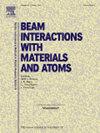Combining ion beam heating, ion irradiation, and infrared imaging enables in situ characterization of radiation damage-dependent thermal properties
IF 1.4
3区 物理与天体物理
Q3 INSTRUMENTS & INSTRUMENTATION
Nuclear Instruments & Methods in Physics Research Section B-beam Interactions With Materials and Atoms
Pub Date : 2025-04-17
DOI:10.1016/j.nimb.2025.165701
引用次数: 0
Abstract
This study investigates a novel method for in situ characterization of thermal properties of solids during ion irradiation experiments. In this method, a focused proton beam creates a localized hot spot, and upon deactivation, an infrared (IR) camera captures the subsequent lateral heat dissipation patterns. When analyzed in conjunction with finite element analysis, the material’s thermal properties can be extracted. By alternating between ion irradiation (using a large beam spot) and focused beam heating (using a small, collimated beam spot), it is feasible to obtain thermal property changes as a function of radiation damage in a single specimen. In this study, 2 MeV proton irradiation/beam heating, IR imaging, and finite element analysis were utilized to examine thermal diffusivity in single-crystal quartz across a range of temperatures and radiation doses. Notably, the results revealed that thermal diffusivity initially increases before decreasing as a function of radiation damage at room temperature.
结合离子束加热、离子辐照和红外成像,可以原位表征辐射损伤相关的热特性
本文研究了一种在离子辐照实验中原位表征固体热性能的新方法。在这种方法中,聚焦的质子束产生一个局部热点,在失活后,红外(IR)摄像机捕捉到随后的横向散热模式。当与有限元分析相结合进行分析时,可以提取材料的热性能。通过离子辐照(使用大光束光斑)和聚焦光束加热(使用小的、准直的光束光斑)之间的交替,可以获得单个试样中作为辐射损伤函数的热性能变化。在这项研究中,利用2 MeV质子辐照/光束加热、红外成像和有限元分析来研究单晶石英在一定温度和辐射剂量下的热扩散率。值得注意的是,结果表明,在室温下,随着辐射损伤的增加,热扩散率先上升后下降。
本文章由计算机程序翻译,如有差异,请以英文原文为准。
求助全文
约1分钟内获得全文
求助全文
来源期刊
CiteScore
2.80
自引率
7.70%
发文量
231
审稿时长
1.9 months
期刊介绍:
Section B of Nuclear Instruments and Methods in Physics Research covers all aspects of the interaction of energetic beams with atoms, molecules and aggregate forms of matter. This includes ion beam analysis and ion beam modification of materials as well as basic data of importance for these studies. Topics of general interest include: atomic collisions in solids, particle channelling, all aspects of collision cascades, the modification of materials by energetic beams, ion implantation, irradiation - induced changes in materials, the physics and chemistry of beam interactions and the analysis of materials by all forms of energetic radiation. Modification by ion, laser and electron beams for the study of electronic materials, metals, ceramics, insulators, polymers and other important and new materials systems are included. Related studies, such as the application of ion beam analysis to biological, archaeological and geological samples as well as applications to solve problems in planetary science are also welcome. Energetic beams of interest include atomic and molecular ions, neutrons, positrons and muons, plasmas directed at surfaces, electron and photon beams, including laser treated surfaces and studies of solids by photon radiation from rotating anodes, synchrotrons, etc. In addition, the interaction between various forms of radiation and radiation-induced deposition processes are relevant.

 求助内容:
求助内容: 应助结果提醒方式:
应助结果提醒方式:


